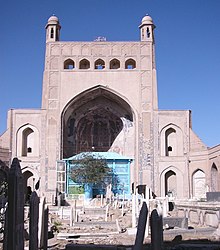Abū Ismāʿīl al-Harawī | |
|---|---|
أبو إسماعيل الهروي | |
 Abdullah Ansari (holding a book) with Abu Ahmad. Folio from Kamal al-Din Gazurgahi's Majalis al-ushshaq, created in Shiraz, Safavid Iran, second half 16th century | |
| Title | Shaykh al-Islām, Sage of Herat |
| Personal | |
| Born | May 4, 1006 |
| Died | 1089 (aged 82-83) |
| Religion | Islam |
| Denomination | Sunni Islam |
| Jurisprudence | Hanbali[3] |
| Creed | Athari[1] |
| Movement | Sufi[2] |
| Muslim leader | |
Influenced | |
| Arabic name | |
| Personal (Ism) | ʿAbd Allāh (عبد الله) |
| Patronymic (Nasab) | Ibn Muḥammad ibn ʿAlī ibn Muḥammad ibn Aḥmad ibn ʿAlī ibn Jaʿfar ibn Manṣūr ibn Matt (بن محمد بن علي بن محمد بن أحمد بن علي بن جعفر بن منصور بن مت) |
| Teknonymic (Kunya) | Abū Ismāʿīl (أبو إسماعيل) |
| Toponymic (Nisba) | al-Harawī (الهروي) |
Abu Ismaïl Abdullah al-Harawi al-Ansari or Abdullah Ansari of Herat (1006–1089) (Persian: خواجه عبدالله انصاری) also known as Pir-i Herat (پیر هرات) "Sage of Herat", was a Sufi saint,[7][8] who lived in Herat (modern-day Afghanistan). Ansari was a commentator on the Qur'an, scholar of the Hanbali school of thought (madhhab), traditionalist, polemicist and spiritual master, known for his oratory and poetic talents in Arabic and Persian.[9]


- ^ Halverson, Jeffry R. (2010). Theology and Creed in Sunni Islam. Pelgrave Macmillan. pp. 47. ISBN 9781137473578.
- ^ Halverson, Jeffry R. (2010). Theology and Creed in Sunni Islam. Pelgrave Macmillan. pp. 48. ISBN 9781137473578.
- ^ Halverson, Jeffry R. (2010). Theology and Creed in Sunni Islam. Pelgrave Macmillan. pp. 37. ISBN 9781137473578.
- ^ Slitine, Moulay; Fitzgerald, Michael (2000). The Invocation of God. Islamic Texts Society. p. 4. ISBN 0946621780.
- ^ Ovamir Anjum. "Sufism without Mysticism: Ibn al-Qayyim's Objectives in Madarij al-Salikin". University of Toledo, Ohio. p. 164.
- ^ Livnat Holtzman (January 2009). "Ibn Qayyim al-Jawziyyah". Essays in Arabic Literary Biography. Bar Ilan University: 219.
- ^ A. G. Ravân Farhâdi, ʻAbd Allāh ibn Muḥammad Anṣārī al-Harawī, "ʻAbdullāh Anṣārī of Herāt (1006-1089 C.E.): an early Shia Ṣūfi master", Routledge, 996.
- ^ "ʿABDALLĀH ANṢĀRĪ – Encyclopaedia Iranica". www.iranicaonline.org. Retrieved 2020-05-31.
- ^ Cite error: The named reference
Iranicawas invoked but never defined (see the help page).